By The White House Historical Association
In 1981, the White House Historical Association created the first Official White House Christmas Ornament, establishing a tradition that honors the presidents of the United States and reflects on the history and events that have taken place in the President’s House.
Produced by the White House Historical Association, a non-profit organization charted in 1961, the ornament is meant to be a way to share the traditions of the Executive Mansion and help the Association fund its mission to preserve the White House and its history for future generations.
The story behind each ornament speaks to the individuality and times in which a president lived, a particular part of his life at 1600 Pennsylvania Avenue. As a collection, they showcase the journey and rich history of the men who have led the country.
This year’s ornament commemorates the presidency of Calvin Coolidge, our 30th President (1923-1929), featuring the first National Christmas Tree decorated with 14 ornaments depicting iconic events of Coolidge’s life and administration.
“Christmas is not a time or a season, but a state of mind.
To cherish peace and goodwill, to be plenteous in mercy,
is to have the real spirit of Christmas.”
– Calvin Coolidge, December 1927
2015: Calvin Coolidge
President Calvin Coolidge was the first chief executive to preside over the National Christmas tree lighting ceremony on the Ellipse in 1923. In addition, Coolidge helped firmly establish a White House tradition of publicly celebrating the “spirit of Christmas.” The tree lighting ceremonies began to be broadcast on radio. On Christmas morning in 1927, he issued a short hand-written message that appeared in major newspapers across the country. It was the first public Christmas greeting to be given to the American people from a president.
During the Coolidges’ first holiday season as First Family, President and Mrs. Coolidge were joined in Washington by their sons Calvin, Jr. and John, home from their school in Pennsylvania for the holidays. Mrs. Coolidge spent her first Christmas Eve as First Lady assisting the Salvation Army in distributing food baskets. Later that afternoon, President Coolidge pressed the button lighting the National Christmas Tree on the Ellipse, a 60-foot tall tree from Vermont (a gift of Middlebury College) that featured over 2,500 electric bulbs. More than 6,000 people came to view the lighting and participate in the singing of Christmas carols on the grounds of the White House.
The Coolidge family had a fairly quiet Christmas Day at the White House. They opened presents around a small tree in the Blue Room, attended church, and enjoyed Christmas dinner. That night, the Coolidges visited with disabled veterans at Walter Reed Hospital.
The 1924 White House Christmas celebration was more somber as the First Family was still mourning the loss of Calvin, Jr. the previous July from a blood infection. Despite the year’s tragic circumstances, the Coolidge family continued their new holiday traditions. Mrs. Coolidge helped distribute 700 food baskets as well as toys and candy to needy children. Like the previous year, thousands came to the White House on Christmas Eve for the lighting of the National Christmas tree followed by carols from a local church choir and the U.S. Marine Band.
In 1925, White House Christmas decorations included mountain laurel, ash branch, and pine cone wreaths. On Christmas Eve, Mrs. Coolidge again volunteered for the needy, attending food basket distributions at nearby Keith’s Theater and Salvation Army Temple. The now-annual National Christmas Tree lighting was brought to the American public by radio broadcast in addition to the 2,000 spectators assembled by President’s Park to witness the event in person. The next day, the Coolidges enjoyed a quiet family dinner.
Christmas Day in 1926 proved quite eventful for the Coolidge family. The day began with the opening of presents in the West Sitting Hall. One special Christmas present was an engraved collar for new White House pet, Rebecca the Raccoon. Originally meant for the president’s Thanksgiving dinner table, the Coolidges soon decided to keep her as a pet. President Coolidge worked on an upcoming speech commemorating the 150th anniversary of Washington and the American army crossing the Delaware River on December 25-26, 1776. Christmas ended with a turkey dinner and a driving tour around Washington with the Coolidges and Frank and Emily Stearns, friends of the first family and guests at the White House for the holidays.
1927 saw President Coolidge flipping the switch for the illumination of 500 lights and 2,000 jeweled reflectors on the National Tree and Washington, D.C. celebrated with the ringing of church bells and the honking of car horns.
For their last Christmas as First Family in 1928, the Coolidges participated in the National Christmas Tree lighting ceremony and spent Christmas Eve and the early part of Christmas Day at the White House before leaving by train for a holiday trip to Sapelo Island, Georgia.
During the 1920s, President Coolidge and his family helped make a White House Christmas a national tradition. Not only did the lighting of the National Christmas Tree become an annual event, but through radio, photography, and increased news coverage, the First Family’s celebration of Christmas became part of the nation’s public holiday festivities.
It was First Lady Jacqueline Kennedy who envisioned a restored White House that conveyed a sense of history though its decorative and fine arts. She sought to inspire Americans, especially children, to explore and engage with American history and its presidents.
The White House Historical Association was established in 1961 to support her vision to preserve and share the Executive Mansion’s legacy for generations to come. Supported entirely by private resources, The White House Historical Association’s mission is to assist in the preservation of the state and public rooms, fund acquisitions for the White House permanent collection, and educate the public on the history of the White House. Since its founding, the Association has given more than $42 million to the White House in fulfillment of its mission.
1981
The 1981 White House Christmas Ornament is the first annual ornament created by the White House Historical Association and depicts an angel in flight.
1982
George Washington, the first president of the United States, 1789-97. A faithful miniature replica of the dove of peace weathervane that Washington commissioned
for his home at Mount Vernon.
1983
John Adams, the second president of the United States, 1797-1801. The first president to live in the White House, the ornament depicts the north façade as he would have known it, before the addition of the columned portico.
1984
Thomas Jefferson, the third President of the United States, 1801-09. Based on the historic Jefferson peace medal, minted in 1801. Jefferson’s portrait is on one side and the opposite shows the clasped hands of an Indian and a soldier.
1985
James Madison, the fourth president of the United States, 1809-17. It celebrates the hospitality and warmth of the Madison White House with two early silhouettes of President and Mrs. Madison.
1986
James Monroe, the fifth president of the United States, 1817-25. Showing the south front of the President’s House as it appeared in 1824 during Christmas and New Year’s festivities.
1987
John Quincy Adams, the sixth president of the United States, 1825-29. Adams, a dedicated gardener, developed the landscape of the White House and established an arboretum of American tree specimens.
1988
Andrew Jackson, the seventh president of the United States, 1829-37. Depicting the president’s children with an invitation to join in their holiday “frolic” in the East Room.
1989
Commemorating the 200th anniversary of the Presidency of the United States with a replica of the official seal of the president. It is this seal that President Rutherford B. Hayes adapted in 1880 to a coat of arms for the president.
Martin Van Buren, 8th President of the United States, 1837-41. The Congress gave him $20,000 for repairs to the mansion including central heating in the main rooms, and he ordered the state parlors redecorated – changing the oval parlor to blue and it has remained so ever since.
1991
William Henry Harrison, the ninth president of the United States, who died just thirty-two days after his inauguration. On March 4, 1841-inauguration day-Harrison mounted a beautiful white charger and led a large procession to the Capital to take his oath of office.
1992
Celebrating the bicentennial of the White House cornerstone, the first building stone of the White House set in 1792. It was officially laid a few months later, on October 13. One face depicts the text of the cornerstone, and on the opposite, reproduced in full color, is an 1848 lithograph of the north side of the White House, based on a watercolor by Augustus Köllner.
1993
John Tyler, the tenth president of the United States,1841-45. The first president to marry while serving as president. His second wife, Julia Gardiner Tyler, was thirty years his junior. Her portrait reduced to resemble a miniature portrait of the sort given as gifts at the time.
1994
James K. Polk, the eleventh president of the United States,1845-49. The cameo features an illustration of the President and Mrs. Polk on the South Lawn while they are serenaded by the United States Marine Band.
1995
Zachary Taylor, the twelfth president of the United States,1849-50. The patriotic theme of this ornament is inspired by ceremonies President Taylor attended at the Washington Monument on July 4, 1850.
1996
Millard Fillmore, the thirteenth president of the United States, 1850-53. The earliest documented Presidential Seal was sketched by Fillmore and sent to Edward Stabler, a nationally renowned seal engraver.
1997
Franklin Pierce, the fourteenth president of the United States,1853-57. The design is inspired by the renovations and redecoration of the White House in 1853 and 1854.
1998
James Buchanan, the fifteenth president of the United States, 1857-61. Depicting the eagle and shield insignia that first appeared on the glassware President Andrew Jackson purchased for the White House in 1829. President Buchanan was the last president to use the Jackson pattern.
1999
President Abraham Lincoln, the sixteenth President of the United States, 1861-65. It features a depiction of Lincoln’s official White House portrait by George P.A. Healy with a hinged frame adapted from a Civil War era frame in the White House collection.
2000
This special edition ornament is made of stone from the same Aquia, VA quarry used to construct the White House. It celebrates the White House 200th anniversary, honoring the past and welcoming America’s future in the new century.
2001
A three-dimensional replica of a carriage of the type used by President Andrew Johnson, who often took carriage rides out into the surrounding countryside to relax with his family after a stressful day.
2002
Honoring the 1902 White House renovation, the crystal-like, acrylic core of the 2002 ornament recalls the Bohemian glass of the elegant East Room chandeliers, a brass metal frame with a holiday ribbon, acanthus leaves from the East Room’s Louis XVI style wall panels, and a sturdy eagle inspired by the carved mahogany pedestals of the console tables.
2003
Ulysses S. Grant, the eighteenth President of the United States, 1869-77. This hand-painted porcelain figure is surrounded by a wreath adorned with toys available at Washington’s fancy goods stores during the Grant administration (1869-77), with a swinging steam locomotive below.
2004
Rutherford B. Hayes, the nineteenth President of the United States, 1877-81. Recreating a snowy scene of a sleigh in winter on the North Lawn of the White House, President Hayes’ favorite season.
2005
James A. Garfield, the twentieth president of the United States, 1881. His term of office, which began in March, ended tragically in when he died more than two months after being shot twice by an assassin. Reflective of Garfield’s personal style, it is comprised of a round ceramic stone featuring a period illustration of the South Front of the White House surrounded by a highly decorative wreath made of gold-finished brass.
2006
President Chester A. Arthur, the twenty-first President of the United States,1881-85. Refleting the period motifs and rich décor of Arthur’s White House, showing the luxurious style that signaled the nation’s return to prosperity after the economic troubles of the late 1870s.
2007
Grover Cleveland, the twenty-second (1885-89) and twenty-fourth (1893-97) President of the United States. This ornament centers on Cleveland first term, during which the 49-year old bachelor married 21-year old Frances Folsom in a small ceremony in the Blue Room. This historic event is the focus of the 2007 ornament.
2008
“We shall have an old-fashioned Christmas Tree for the grandchildren upstairs, and I shall be their Santa Claus myself.” – President Benjamin Harrison, the twenty-third President of the United States, 1889-93. Harrison was the centennial president inaugurated 100 years after George Washington. Inspired by Harrison family’s Victorian Christmas tree, this ornament interprets the first recorded tree to decorate the White House.
2009
Back in the White House as the twenty-fourth President of the United States, this second ornament for Grover Cleveland illustrates the holiday celebrations of President Cleveland’s young family, showing the south façade of the White House after an evening snowfall. The warm glow of the first Christmas tree to be illuminated by electric lights.
William McKinley, the twenty-fifth president of the United States, 1897-1901. Fodusing on the role of music in the traditions of the White House, the McKinley administration is remembered as a time when the nation become an international power. The patriotic mood as the century turned is shown in the illustrations commissioned for the 2010 ornament with scenes from the annual Army Navy Reception at the White House in 1900.
2011
Theodore Roosevelt, the twenty-sixth president of the United States, 1901-09. The front face of the ornament is a color illustration derived from a political cartoon drawn by William A. Rogers in 1901 capturing the anticipation associated with the young family’s first White House Christmas.
2012
William Howard Taft, the twenty-seventh President of the United States, 1909-13. Taft introduced the automobile to White House transportation in 1909. The ornament celebrates Taft’s adoption of the automobile, his love of manufacture and invention, and his ready acceptance of modernity. It depicts President and Mrs. Taft delivering Christmas presents in the White Motor Company’s Model M, a seven passenger steam-powered touring car embellished with the Great Seal of the United States on the doors.
2013
Woodrow Wilson, the twenty-eighth president of the United States, 1913-1921. Defined by the unprecedented devastation of World War I, Wilson himself was awarded the Nobel Peace Prize in 1919 and his life is distinguished by his resolve that the Great War would truly be the war to end all wars. The centerpiece is an American Elm tree planted by President Wilson on the North Lawn of the White House on December 18, 1913, just before Christmas.
2014
Warren G. Harding, the twenty-ninth president of the United States, 1921-1923. Harding dreamed of being a locomotive engineer-a wish that was to come true for 51 minutes when as president, he took over the controls on the Alaskan railroad during the “Voyage of Understanding,” his famous transcontinental speaking and sightseeing tour. The ornament is a detailed miniature replica of one of several steam-powered locomotives that pulled the Presidential Special, attached to the coal car that held its fuel, along with the Superb, the president’s private heavyweight Pullman car.



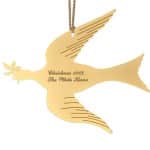

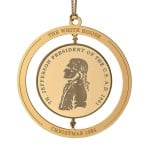
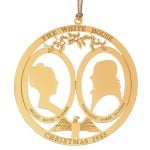
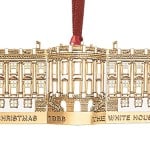
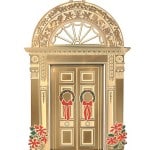
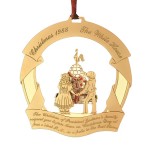
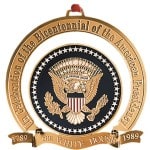
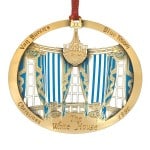

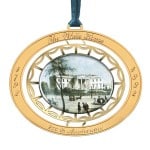
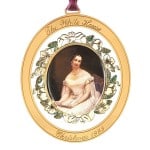
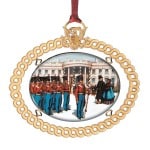
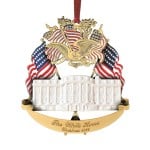
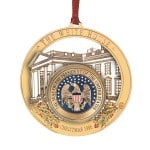



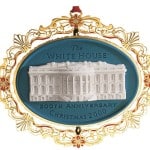
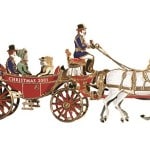
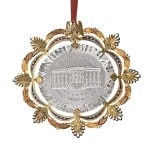
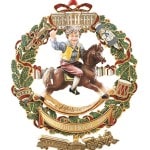
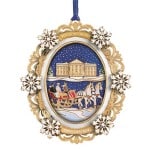
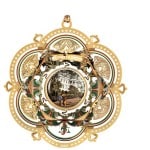
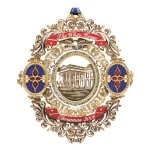

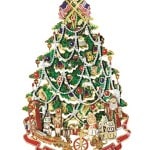


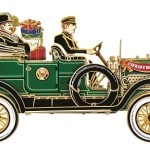
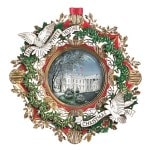

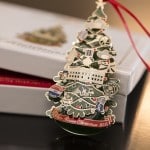



Related posts: